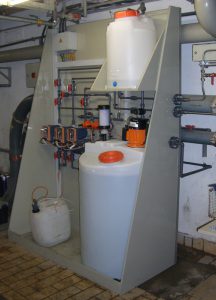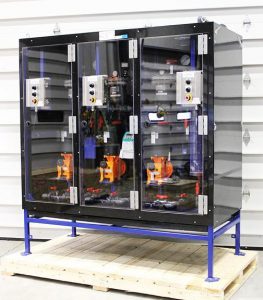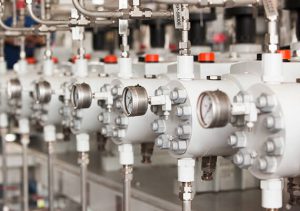The dosing pump, as its name implies, can determine the amount of fluid passing through. Dosing pumps are used in industries where some liquid must be added to the main fluid. For example, for chlorination, a dosing pump is used to measure and control the amount of chlorine entering the water. Dosing pump has different models and applications, which we will talk about later.
Dosing pump or measuring pump, or in other words pump metering, is a pump that pumps (injects) a certain amount (specific dose) of a fluid. Therefore, in dosing pump systems, the amount of flow and pressure are among the important parameters, and for this reason, all dosing pumps made have adjustable flow. One of the indicators that distinguishes the dosing pump from similar pumps is the ability to change the reciprocating course. In all dosing pumps, the flow rate can be changed by changing the course. In the following, we will explain how the dosing pump works, their types and applications.
What is a dosing pump?
Dosing pumps are used for chlorination and injection of acid and alkali and in general injection of a certain amount of fluid into tanks and pools or pressurized pipes. These pumps are available in the market with polypropylene, PVC, PVD and stainless steel materials, and the minimum flow capacity available for them is one liter per hour and a pressure of 10 times. The dosing pressure of the pump is announced in terms of atmosphere or water meter or load. The viscosity and stiffness of the injected material affect the choice of the type and strength of the dosing pump.
Types of dosing pumps
Dosing pumps can be categorized in different ways. In the following, we will refer to different types of dosing pumps based on their specific categories.
Types of dosing pumps in terms of pumpable materials
- Dosing pump powder and granules.
- These pumps are used to transfer solids with high viscosity.
- These pumps are mostly used in plastic and food industries.
- Dosing pump for a variety of liquids and chemicals.
- These pumps are used to transfer various liquids.
- The use of these pumps is more and in the following we will talk more about the same model of pumps.
Types of dosing pumps in terms of working mechanism
- Single phase solenoid
- Piston
- Diaphragm
- Hydraulic
- Diaphragm hydraulic piston
- Pneumatic pneumatic
Types of dosing pumps in terms of material used
The part of the dosing pump that comes in contact with the chemical is called wet or wet. The wet part of the pump is usually made of anti-corrosion material. The common genders of this section are as follows.
Polypropylene PolyPropylene. This material is cost effective and can be used for most materials with low corrosion.
PVC PVC. This material is almost similar to polypropylene, but due to the presence of chlorine in its structure, it is compatible with chlorine and is more suitable for fluids that have a high percentage of chlorine.
PVDF. This material is well compatible with almost all chemicals and also has a higher pressure tolerance than the previous two materials.
Stainless Steel. This material is impact resistant and its selection prevents damage to the pump due to human error. It is also compatible with many materials and its corrosion is very low.
Applications of dosing pumps in water and wastewater industry
To prevent corrosion in the treatment system, water enters the boilers and boilers and the material is pumped to adjust the pH.
Sodium hypochlorite (Naocl) of Javelin or Vitex is used to disinfect water in pipelines.
Aluminum Sulfate, Aluminum Chloride Sulfate Hydroxide is used for coagulation in the treatment system.
Antiscalant is used to prevent fouling in the RO system.
Used to control pH, acids and alkalis.
Potassium permanganate is used to remove manganese and iron in the treatment system with the help of a dosing pump.
Polyphosphate is used to harden water.
Sodium biosulfate is used to eliminate water-soluble oxygen.
To absorb cyanide and water-soluble metallic substances and regulate the pH, baking soda or caustic soda (Castic or Naoh sodium hydroxide) is used with the help of a dosing pump.
Applications of dosing pumps in chemical and petrochemical industries
To regulate pH or polymerization, injection of various acids, sulfuric, nitric and is used.
Used to inject paint into gasoline.
Used for injecting anti-lock and alcohol into gasoline.
Applications of dosing pumps in pharmaceutical and wood industries
Add a variety of essential oils, enzymes, acids and bases
Injection of oils, solvents, chlorine, additives and dyes
Chlorine injection for bleaching paper
Add a variety of dyes and pigments
Resin to increase the water resistance of the paper
Advantages of dosing pump
It has the ability to transfer liquids with solid particles, catalysts, etc., and different models can be used for different materials.
They can pump even low-fat liquids.
Compared to other pumps, they have low weight, smaller size and lower installation costs.
They have freer ridges, their parts do not touch or rub against each other. Abrasion in their parts is minimal.
At a constant speed and at the same time do not need a guard against a sudden increase in speed.
There is no limit to the pressure of a given flow.
They can also transfer liquids with high viscosity.
Their flow rate is affected by Narration is not specific to fluid.
Iranian dosing pump dosing pump
Dosing pump is used for precise chemical injection, chlorine injection, anti-scaling injection and SBS and injection of anti-fouling and anti-corrosion types.
It has a flow rate of 5 cubic meters per hour and a pressure above 7 bar, which can be adjusted according to the type of consumption.
Specifications of Iranian dosing pump dosing pump:
Dimensions 20x14x16 cm
Weight 2.8 kg
Type of clean water fluid, contaminated water, chemicals
Pool application, fluid transfer, chemical injection, pressure control
Dosing pump specifications of Iranian dosing pump:
Ability to immerse: None
Fluid type: clean water, contaminated water, chemicals
Application: swimming pool, fluid transfer, chemical injection, pressure control
Pump body material: polypropylene
Engine specifications (accompanying items) Iranian dosing pump:
Suction valve
Injection valve
Other details of Iranian dosing pump:
Has PTFE aperture
Made of PP or PVDF head material
Material of Oering Lip Volvo VITON
Even PP polypropylene injection
PP filter
4 meter PE hose for suction / discharge



I was able to find good information from your12 articles.